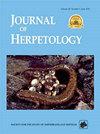A Long-Term Study of Coachella Fringe-Toed Lizards, Uma inornata, Reveals Seasonal and Annual Variation in Size and Growth
IF 0.8
4区 生物学
Q3 ZOOLOGY
引用次数: 0
Abstract
Abstract. Productivity of warm deserts is highly correlated with rainfall. We analyzed body size data from a 35-yr study of Coachella Fringe-Toed Lizards, Uma inornata, to reveal precipitation-related differences among years both in growth and in the length–mass relationship (LMR). The LMR is a linear function enabling comparison of regression coefficients among groups. Adult male U. inornata were significantly larger and their maximum size differed substantially from that of females. Comparing regression coefficients of LMR between sexes revealed equal slopes, although intercepts differed slightly but significantly. We treated the sexes independently to test for seasonal and rainfall differences. Comparing seasonal differences among adults revealed that slopes were not parallel. Regression coefficients predicted that individuals weighed more in spring than in fall, which we attribute to winter rainfall. This was corroborated by recapture data. LMR slopes for extreme dry, extreme wet, and typical rainfall years were parallel, but the elevation for typical years differed significantly from both dry and wet years: they were heavier in typical years. Growth was slower in dry years than in wet or typical years. Differences in growth rates affect time to maturity. We used the production relation model of juvenile growth to estimate time to minimum reproductive size. Time to maturity is doubled during dry years in comparison with wet years (542 vs. 288 d for females, 400 vs. 200 d for males). Together, delayed maturity and predicted future increases in drought frequency and intensity imply conservation concerns for this protected species.对科切拉条纹趾蜥蜴的长期研究揭示了其大小和生长的季节性和年度变化
摘要温暖沙漠的生产力与降雨高度相关。我们分析了来自Coachella fre - toe Lizards, Uma inornata的35年研究的体型数据,以揭示不同年份在生长和长度-质量关系(LMR)方面与降水相关的差异。LMR是一个线性函数,可以比较组间的回归系数。成年雄斑蝶体型显著大于雌斑蝶,其最大体型与雌斑蝶差异显著。性别间LMR回归系数比较显示斜率相等,截距略有差异,但差异显著。我们对不同性别进行了独立处理,以测试季节和降雨量的差异。比较成年人之间的季节差异发现斜坡并不平行。回归系数预测春季个体体重大于秋季,我们将其归因于冬季降雨。这一点得到了重新捕获数据的证实。极端干旱年、极端潮湿年和典型降雨年的LMR坡面是平行的,但典型年的海拔高度与干湿年都存在显著差异:典型年的海拔高度比典型年大。干旱年份的生长速度比潮湿年份或典型年份慢。生长速率的差异影响到成熟的时间。我们利用幼鱼生长的生产关系模型来估计达到最小生殖尺寸所需的时间。干旱年份的成熟时间是湿润年份的两倍(雌性542天和288天,雄性400天和200天)。总之,延迟成熟和预测未来干旱频率和强度的增加暗示了对这种受保护物种的保护问题。
本文章由计算机程序翻译,如有差异,请以英文原文为准。
求助全文
约1分钟内获得全文
求助全文
来源期刊

Journal of Herpetology
生物-动物学
CiteScore
1.60
自引率
0.00%
发文量
45
审稿时长
6 months
期刊介绍:
The Journal of Herpetology accepts manuscripts on all aspects on the biology of amphibians and reptiles including their behavior, conservation, ecology, morphology, physiology, and systematics, as well as herpetological education. We encourage authors to submit manuscripts that are data-driven and rigorous tests of hypotheses, or provide thorough descriptions of novel taxa (living or fossil). Topics may address theoretical issues in a thoughtful, quantitative way. Reviews and policy papers that provide new insight on the herpetological sciences are also welcome, but they must be more than simple literature reviews. These papers must have a central focus that propose a new argument for understanding a concept or a new approach for answering a question or solving a problem. Focus sections that combine papers on related topics are normally determined by the Editors. Publication in the Long-Term Perspectives section is by invitation only. Papers on captive breeding, new techniques or sampling methods, anecdotal or isolated natural history observations, geographic range extensions, and essays should be submitted to our sister journal, Herpetological Review.
 求助内容:
求助内容: 应助结果提醒方式:
应助结果提醒方式:


